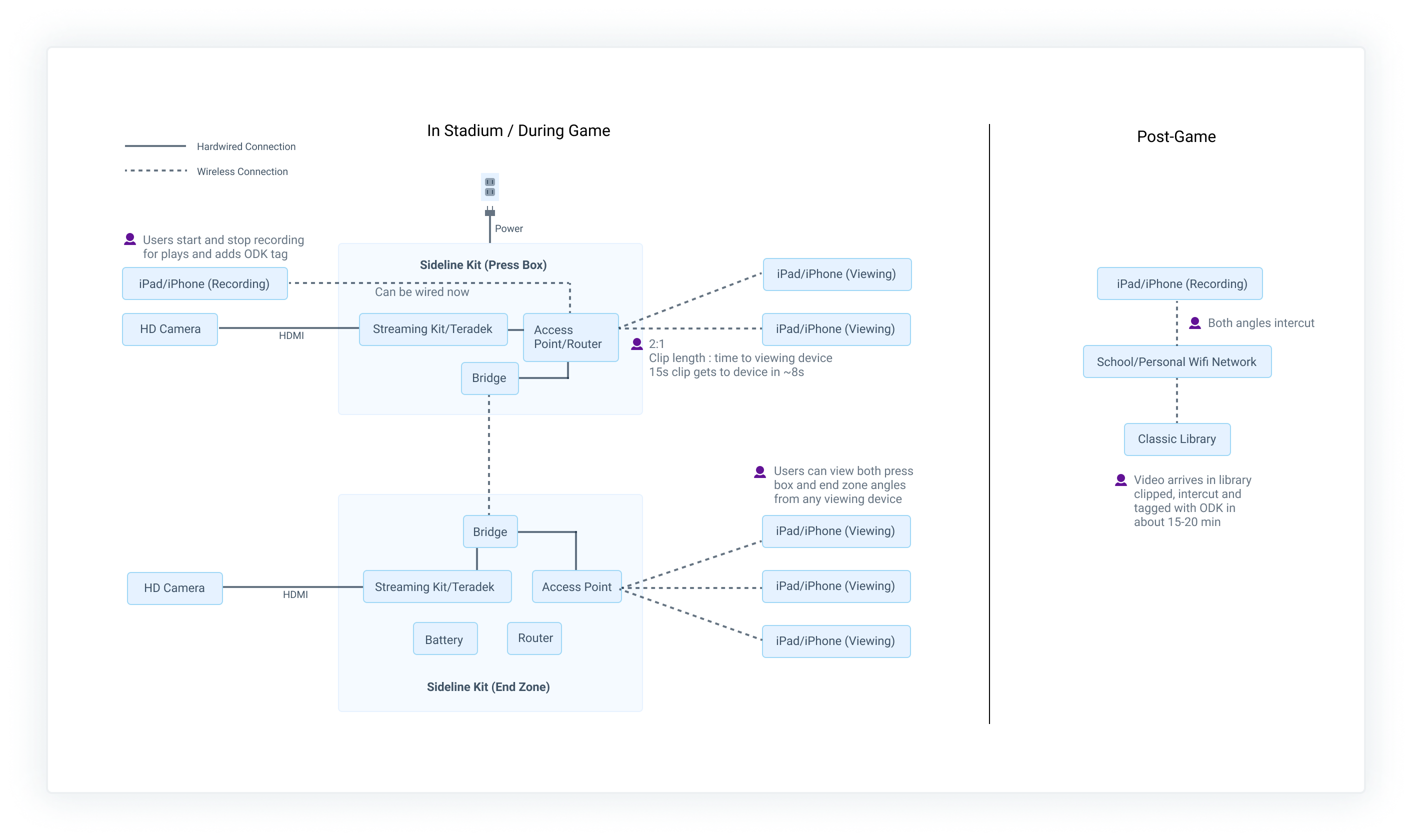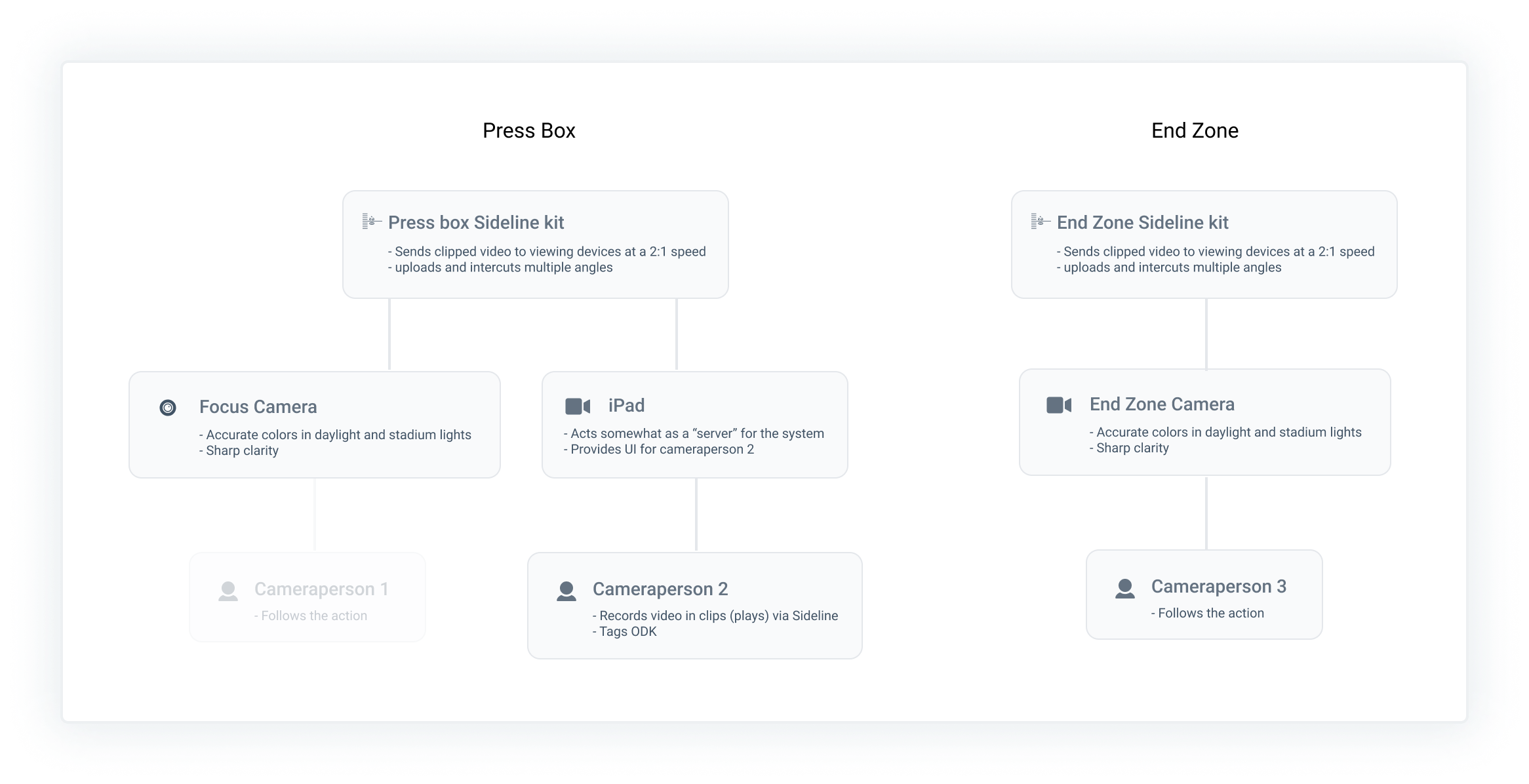Automatic Capture for Stadium Sports
My Role: As the sole product designer on the project, my responsibilities included co-leading initial market research with my PM, communicating and advocating for the needs of our outdoor sports customers, UX design and leading research for an alpha and beta season with the camera.
My Team: One PM + two full engineering teams. In addition, I worked closely with our hardware design, sales, marketing and support teams.

Summary
Hudl Focus Outdoor is a smart camera that automatically captures outdoor athletic events. This camera is an evolution of Hudl’s smart camera for indoor sports, tailored specifically for the needs of stadium teams.
The project demonstrates:
- Hardware-integrated design
- Algorithm-driven design
- Heavy user research and success definition
Business Problem
Hudl launched a smart camera in 2018 to meet the needs of indoor high school and small college sports teams, primarily basketball and volleyball. Shortly after, the company ran with a sales strategy targeting entire athletic departments at these organizations. In most states in the US, American football programs are a primary driver for decision-making within athletic departments at this level. Basketball coaches, volleyball coaches and ADs alike LOVED the indoor Focus Camera. Needless to say, football coaches were chomping at the bit to get a smart camera of their own. The sales team reported that not having a camera to sell to outdoor teams as part of the AD packages was a major blocker.
Goal
Our responsibility was to launch 6500 smart cameras in the fall of 2021 to high schools and small colleges that met the needs of our outdoor sports customers, with an initial focus on American Football.
Process
The project began with initial research conducted by me and my PM. The purpose was to validate the “hierarchy of needs” drafted by my PM and begin collecting more specific details about the experience we needed to provide to football teams. Once we had engineering resources I began brainstorming with the team to build small slices of the experience we needed to deliver.
I was the primary advocate for a beta season with the camera to allow us to test and validate the function of the camera. Due to some football seasons being delayed because of Covid, we were able to run two test seasons—one in the fall and one in the spring allowing precious time to continue to test. Throughout the project, I led interviews and user tests with over 30 coaches, and analyzed over 300 survey responses, in addition to connecting with many coaches over email. Although documentation of research findings was critical for such a distributed team, I also ensured team members from engineers, to sales and marketing, to support were invited to chats with our customers. Not only did this save me time, but it got them closer to the customer so they could hear directly from the coaches and ADs themselves on the problems we needed to solve.
To measure the success of the camera, I worked collaboratively with my PMs to come up with our user-centered project metrics and led the charge in structuring our beta research, metrics and results space in a way that people could easily digest. The space was shared with our project's Weekly Leadership Briefing and received praise from the Chief Product Officer and VP of Design for being user-centered and easy to keep up-to-date with progress.



When I wasn’t leading interviews or communicating research findings, I was working directly with our engineering teams designing experiences that met the unique needs of football teams.

Six Hats brainstorm on two areas of the Focus experience
Validating the "Hierarchy of Needs"
Device That Works
The majority of this was done by our two hardware designers along with the hardware engineers. But because the Outdoor Focus team was operating somewhat like a startup there were a few areas that I plugged in to help move this area of design along. Primarily, I was soliciting and reporting back on all the feedback surrounding the device itself. This included installation, onboarding and environmental factors (like weather) in the field.

Example of a prototype installation from a customer that was experiencing issues with shakiness
Follows the Action
I collected information during our initial round of research about how coaches preferred to record their games. I used questions such as “How do you instruct your cameraperson to record games?” to find what we were looking for.
Engineers worked on this functionality over the summer and we were able to start collecting feedback on our first iteration during the fall beta. We learned during fall beta that most coaches thought it was okay, but not good enough that they were using the video to coach their own team. This was our indicator that we needed to improve how the camera tracked the action.
During the spring beta, we discovered the issue mentioned in the section above with camera shakiness was accounting for a portion of teams who were dissatisfied with the play tracking. With this discovery, our engineering team was able to push a fix out before the end of the spring beta.
The final finding from the betas was the primary reason coaches were not using Focus video to coach their team each week. The algorithm wasn’t good at capturing long plays like deep passes, punts and kickoffs. We were missing important action and therefore coaches weren’t quite ready to give up recording with their own camera.
?
“How do you instruct your cameraperson to record your games and practices?”
Video Quality
Football coaches are used to recording their games with HD (sometimes 4K) video cameras. We knew we needed to meet or exceed that with the quality of Focus video. Overall, video quality tested very well throughout the betas. Through feedback from coaches, I identified two patterns among coaches who rated video quality negatively. First, colors and contrast under stadium lights and second, the picture-in-picture scoreboard was unreadable once daylight was gone.
Uploads to Library in a Usable Format
Football teams record games play by play, starting and stopping recording between each one. When they upload the video to Hudl, it's uploaded in these separate video clips so they can navigate video play-by-play and add specific data to each. This is not the case for most indoor sports, which consume video in a longer stream of video. Because of this, the Focus camera was originally designed to record and upload one video file of the entire game.
We learned quickly during the fall beta that coaches had no use for the single stream of video and were unwilling to clip up the video after it was uploaded. Our machine learning team jumped to find a way to automatically clip the video based on an algorithm that identified the beginning and end of each play.
I sent test playlists of videos to a few of my close customers to get initial feedback on the test video we had and further validated the accuracy of clipping during the spring beta with their own video. Coaches were very happy with clip accuracy, some even mentioning it was better than the video they were used to.


Works with Sideline
The integration with Sideline, an instant replay product in the Hudl suite, was completely new functionality with the Focus product—other sports do not have an instant replay system. The goal for solving this problem was to ensure that coaches didn’t need to keep setting up their handycam to supply the video for Sideline, instead the Focus camera should provide that. There was very little UI work to be done for this integration so my focus was primarily on, educating the engineering team on how customers used Sideline, making and communicating UX decisions and ensuring the physical setup between the two systems was quick and simple for coaches.

Visualization used to help educate the engineering team on how Sideline works
Although I had extensive background knowledge of the Sideline product and how our customers used it, I still wanted to hear from coaches about their expectations for how Focus would integrate with Sideline. I met with a handful of coaches to listen to their thoughts. I used the visual below to prompt conversation about how we thought about the integration. Through this, I learned coaches had questions about connecting and disconnecting the camera from the system when switching between home and away games as well as if it would work for their end zone camera. Ultimately, they were very excited to have one less person up in the press box running their recording setup with this initial integration.

In addition to coaches' concerns about connecting Focus and Sideline each week, we ran a usability test with Sideline experts from our support team to observe how setup between the two went and to identify issues. We learned it was difficult to find the correct ports inside the Sideline kit. In addition, we needed them to take out a piece of hardware in the kit that was explicitly labeled in the box to leave in place. Finally, there were two different versions of the Sideline kits out in the field with different hardware that we needed to account for as the setup instructions would be different for each.
To solve these issues I worked with our content designer and marketing team to ensure instructions being sent with the prototype cameras would be clear and provide visuals so coaches could quickly identify proper equipment and ports. I also worked with our hardware supply team to choose cables and labels that would ease setup confusion as well.

One update needed to be made to the app. That was to include the Focus camera in the troubleshooting system for the Sideline app. I utilized existing patterns to include a specific alert for Focus as well as the unique troubleshooting steps.

Outcomes
Ultimately we tested 199 cameras over the course of the two betas. The feedback collected through those tests allowed us to iterate throughout the betas as well as set up a roadmap for the rest of the year to keep marching toward hitting the metrics for the product. The camera launched in the fall of 2021.